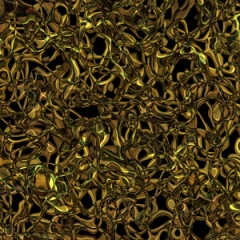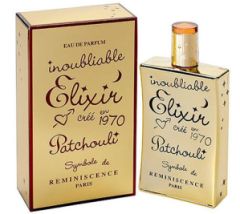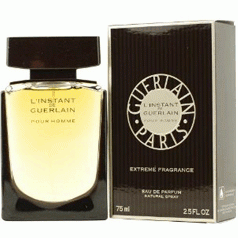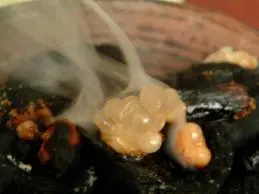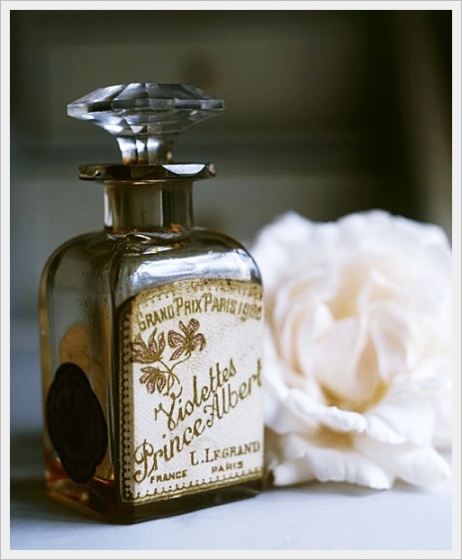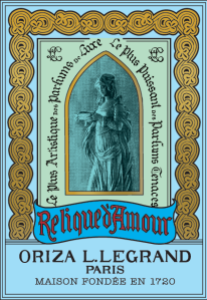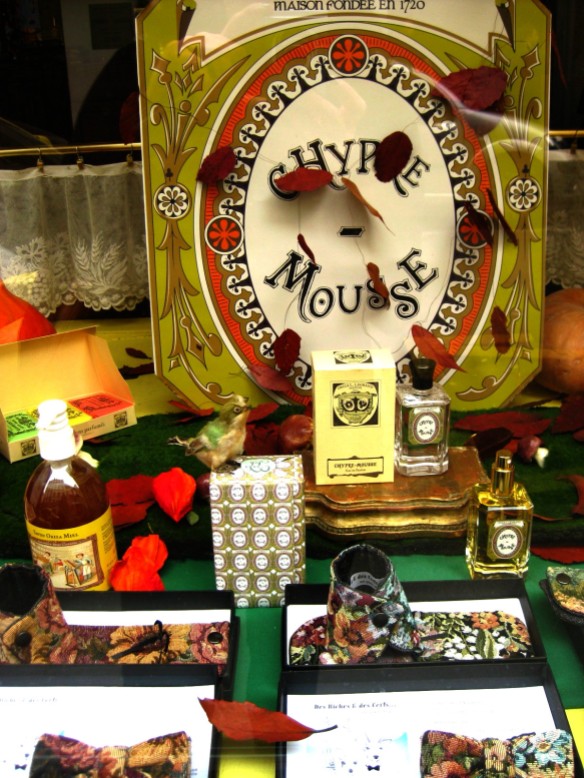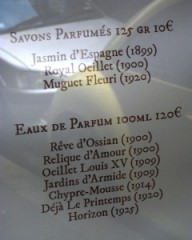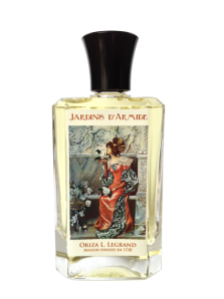I thought I’d begin my patchouli series at the beginning with the referential benchmark perfume which started it all. It was 1970 when Reminiscence Paris released Patchouli, the fragrance which would be forever tied to their name in many people’s minds. A true, dirty, woody patchouli, Reminiscence’s eau de toilette was very much a product of its times, and embodies all that the negative associations with the note: the “Summer of Love,” dirty hippies, and a “head-shop” earthiness. Yet, Reminiscence’s Patchouli remains a cult hit and, for many, the standard by which all other scents in the genre are measured. For a few of my friends, the perfume is known merely as “Reminiscence,” as if there were nothing else. I myself call it the same thing. So, to avoid endless redundancy in talking about both the note and the perfume name, I’ll simply refer to the scent from now on as “Reminiscence.”
In 2007, the company issued a flanker called Elixir de Patchouli. Though there have been a few Reminiscence spin-offs of the 1970 original, the Elixir is an eau de parfum that is intended to be a deeper, richer version of Patchouli, a daughter more than a cousin. The two fragrances seem largely alike on the surface, especially when you spray on a lot. They both open as extremely boozy, cognac-like patchoulis, but they diverge later on to some extent. However, if you apply a minimal quantity, the differences between the Reminiscence and the Elixir are much more noticeable. I thought I would analyse each one in turn.
PATCHOULI:
Patchouli is an eau de toilette which Reminiscence describes as an “Oriental Woody” with the following olfactory pyramid:
Top and Heart Notes :
Woody (Essential Oil Virginia Cedar, Essential Oil Javanese Patchouli, Essential Oil Haitian Vetiver, Essential Oil Australian Sandalwood)
Base Notes :
Ambery (Spanish Labdanum Absolute)
Sweet (Madagascan Vanilla Absolute, Tonka Bean Absolute),
Balsamic (Tolu Balm Resinoid),
Musky (White Musk)
If you apply a lot of Reminiscence, its opening is all boozy cognac followed by hints of dark chocolate. Four big smears creates a potent, forceful, truly intense cloud of dark patchouli where the aged cognac essentially trumps all for a good portion of the opening 15-minutes. However, I think the perfume’s true characteristics and nuances are most evident with a lesser, perhaps more normal dosage, so my breakdown will talk about what the fragrance is like with 2 big smears which would be the equivalent of 2 small sprays. Given the famed potency of Reminiscence in its opening stage, I’m not sure anyone would ever apply more than 2 small sprays anyway.
Reminiscence opens on my skin as a powerful force-field of chewy, earthy, leathery sweetness infused with smoky cedar. The immediate impression is of dark patchouli that is sweet, spicy, and musky, with hints of dry woods, and smoke. More significant, perhaps, is a note that can only be described as a wet, mushy, salty touch, almost like ambergris. To my surprise, Reminiscence is surprisingly sheer for such a massively strong perfume, and feels as though it has no weight at all.
There is a definite greenness underlying the dark brown, red, black notes. The perfume makes me imagine a wet, terracotta-brown, sloping, river bank of musky earth at the base of a big cedar tree. Out of the mushy soil sprout dark green leaves that smell a little medicinal. Yet, there is also sweetness in the air. From afar, the patchouli smells like smoky, bitter-sweet chocolate toffee with spices, leather, a whisper of nuttiness, and a whole lot of funk. Up close, however, the patchouli is primarily woody and dry in nature. There are also clearly synthetics in the base, something that eventually gives me a little bit of a headache. I suspect it’s my nemesis, the white musk.
Ten minutes in, Reminiscence starts to slowly shift. The chocolate rises to the surface. It’s dark but semi-sweet, with an almost expresso-like undertone. The vetiver soon explodes in full force, smelling as smoked as the cedar that it joins, and the two together cut through Reminiscence’s sweetness. They add a definite dry, forest feel to the visuals of wet, red earth. As the smoked vetiver and dry cedar bloom, so do the dark, green patchouli leaves, turning very medinal and camphorated. I don’t have my sample of Serge Lutens‘ Borneo 1834 to compare to Reminiscence side by side, but there are definite similarities in the mentholated notes. However, the Reminiscence seems more heavily dominated by the smoked vetiver and cedar than the Lutens. It is stronger in smell, but sheerer in feel, and it also seems dirtier.
The Reminiscence smells a lot like chilled peppermint and bitter chocolate with heavy amounts of smoky vetiver and cedar. In some ways, it reminds me of the American sweet, a York Peppermint Pattie, only much drier and woodier. I find myself oddly apathetic to it all, perhaps because I wish there were more sweetness, and much more weight. It doesn’t feel molten, thick and opaque, no matter how strong it may be up close.
The projection isn’t enormous either, though you may get fooled by the strength of the perfume’s notes up close. (With 4 enormous smears, however, the projection is nuclear, and the fragrance can be smelled across the room.) Yet, for all that the sillage is average with a low dose, the Reminiscence still sends little tendrils into the air around you, weaving a dark spell that is a mix of sweetness, earthiness and dry, smoked woods.
After 20 minutes, Reminiscence begins to transition. The medicinal, mentholated aspect to the funk becomes stronger, and the perfume definitely seems like something suited to the ’70s or to the hippies at Woodstock. I like parts of it, and others I don’t. The synthetic clang in the base gives me a headache, and the notes are too intensely mentholated for my tastes. I smell like a bitter, dark chocolate version of a York Peppermint Patty, mixed with an athlete’s muscle rub, and a hefty dose of smoked, dark vetiver. The cedar pops in and out, lending even more woody dryness whenever it appears.
I think people who are used to a much sweeter, more modern patchouli fragrance where the note is infused with vanilla from the start may get a little bit of a shock to their system at the medicinal funk and vetiver woodiness of the Reminiscence. This is definitely patchouli, yes, but it is a significantly darker, more bitter, medicinal camphorated version than many of its descendants from other brands.
It isn’t until the start of the second hour that Reminiscence pipes down a little. The vanilla suddenly appears, and it changes the scent quite dramatically. The perfume is increasingly a soft, balmy, mellow patchouli atop a light vanilla base infused by cedar and vetiver. The bitter dark chocolate has turned to milk chocolate, and the medicinal aspects are diffused, returning to a pleasant peppermint note. The sillage drops, the notes blend into each other, the perfume is sweeter, and the whole thing feels even gauzier. Around 90-minutes in, Reminiscence is a sheer, spicy, creamy patchouli infused with sweetness, smoky woods and vanilla.
At the end of the third hour, Reminiscence is a total skin scent, and a mere blur of ambered sweetness that just barely smells of patchouli. I have the impression that the fragrance has vanished in areas, and I’m profoundly dubious that it’s actually going to last. To my surprise, however, Reminiscence hangs on, though it turns increasingly vanilla-oriented in focus. About 5.5 hours in, it’s almost all vanilla with just the faintest hint of patchouli and cocoa powder. It finally dies completely around 7.5 hours from the first spray, leaving as a mere vanilla blur.
At double the dosage, Reminiscence has differences in notes, sillage and longevity. The sillage still drops at the end of the first hour, but it takes two hours in total before the fragrance begins to soften and mellow out. The Reminiscence still becomes a skin scent at the end of the third hour, but the total duration is considerably extended to roughly 11.75 hours in length.
The major differences in smell are most noticeable in the opening blast which is suddenly boozy, like aged Armagnac brandy or cognac, in a way that was completely absent at the lower, normal amount. The other differences are primarily of degree. The Reminiscence becomes even more overtly medicinal and dirty with the larger dose, and the fragrance remains that way for a longer period of time. It takes almost 3 hours from the start for the mentholated, earthy, medicinal funk to mellow out, and for the vanilla to soften the patchouli. Oddly, the fragrance takes on a more ambered labdanum undertone at the double dose, and around the middle of the third hour. It’s less vanilla-centered quite so soon, more golden and soft. Eventually, though, Reminiscence eventually ends up the exact same way, as vanilla with patchouli and cocoa powder, then just vanilla in its final moments.
As regular readers know, I’ve been on a hunt for a replica of my holy grail patchouli scent that I wore when I was 14-years old, and which I thought was from the French jewellery house, Ylang-Ylang. It as a glorious dark patchouli with Mysore sandalwood, vanilla, and a light floral touch. Lately, I’ve been wondering if my memory was off, and my holy grail scent was really from Reminiscence. After all, both are jewellery houses started in the South of France, with a similar aesthetic and look. Was I merely confusing the two? I can visualize the store in Monte-Carlo down to a T, but had I gotten the name wrong all this time? I don’t think so, but, when I asked a childhood friend from Monte-Carlo about Ylang-Ylang and a patchouli scent, she said, “It has to be Reminiscence.”
So, when I was in Paris, I took her to the store to see if Reminiscence was the same scent I remember. We sprayed it on our wrists, and I was sniffing mine when she started to shake her head. “This can’t be right,” she said. “It didn’t smell like this. I can’t forget the smell, since half the girls in my high school wore Reminiscence. And this isn’t it!” I asked the sales assistant if the fragrance had been changed, only to receive vehement denials. I don’t believe her. My original favorite had a heavy sandalwood aroma, and while I’m still convinced my holy grail came from “Ylang-Ylang” not Reminiscence, their fragrance also had Mysore sandalwood. Now, however, the perfume lists “Australian sandalwood” as one of its notes. I could not detect sandalwood in any way in the modern Reminiscence Patchouli that I tested, perhaps because the Australian version is utter crap, bland as hell, and isn’t real sandalwood. (Sorry, I know I sound like the biggest snob alive when it comes to this issue, but the two things truly are not alike!)
My memory aside, my friend is convinced that Reminiscence has changed from the fragrance she knew so well — and she’s not the only one. On Surrender to Chance, someone wrote the following comment:
I wore this yummy fragrance over 20 years ago and am assuming they changed the formula….it does not smell like it used to and my family agrees:( so bummed out[.]
Reminiscence Patchouli is perfectly fine, but I found myself strangely apathetic about it. I don’t know why because, in some ways, it’s really quite nice at a higher dosage: the sharpness of the synthetic musk in the base is hidden; the boozy cognac at the top is pretty, as is the amber that shows up later, and the longevity is much improved.
I think the perfume is simply too mentholated at one stage for my personal tastes, too bitter, and with too much smoky vetiver. I need a counterbalance to all that dry woodiness, and much more sweetness to dilute the medicinal tone. Later, when the sweetness does arrive, and the camphor retreats, the fragrance is simply too wispy in feel. I hate how it goes from one extreme (potency), to the other (wispy, sheer skin scent) as quickly as it does, and I don’t approve of the fragrance’s lightweight feel in general.
Sometimes, the original benchmark classic cannot be improved upon, as vintage Opium demonstrates full well. Occasionally, however, modern successors take the blueprint set by the pioneers, and make it much better. I think Reminiscence’s Patchouli falls into the latter category. I’m know it was innovative for its time, and I feel it was probably better before it was reformulated, but the current version is far from perfect, and I think there are better patchouli fragrances on the market. Profumum‘s Patchouly definitely comes to mind, as do a few scents I will write about later this week.
A number of readers on Fragrantica don’t share my opinion. Take the issue of longevity and sillage. The majority (10) vote for “very long lasting,” followed by “long lasting,” while the sillage votes are split with 10 votes for “enormous” and 10 for “heavy.” Almost all the comments on the site are very positive, with a few comparing the fragrance favorably to patchouli niches from Montale, Micallef, and Molinard:
- I absolutely loved the clean balminess of Pathcouli. That’s certainly the next best thing to Montale‘s Patchouli Leaves which I declared as my number one. I’ll not compare the two here though. In its own right, Reminiscence’s Patchouli is one of the best, cleanest, dreamiest patchouli fragrances you can ever try. No sharpness, no mustyness, no zesty/citrusy or artificial extra notes whatsoever… That’s the real stuff (some good quality patchouli oil) which has a distinctive “oily” smell reminding me of pure unadultered olive oil. In this respect it’s certainly “exotic”, quite Middle Eastern indeed[.] [Emphasis added by me to name.]
- This one opens with incense shop and dry cedar wood. Then, a creamy vanilla and praline ensues and tempers the rather moody patch note at the bottom. It’s like teleporting from a Moroccan side street to a Venetian cafe for gelato. I thought at first this one was bitter, but comparing it to Molinard Patchouli and Montale, it’s actually on the sweet side. And I really, really, love it. It is a hippie gourmand essence, but harkens back to some more innocent and hopeful hippie hour; before 1968, say. [Emphasis added by me to name.]
- A very beautiful and quite heavy patchouli on a woody base.It smells quite like patchouli oil,very concentrated and powerful. Reminds me of Micallef Patchouli,but Reminiscence’s Patchouli is way stronger and darker.The drydown is a bit sweet patchouli with wood.A hippie patchouli,all the way!It has very good lasting power and sillage! [Emphasis added by me to name.]
- I think that this is the smoothest of [Reminiscence’s] patchouli blends, and I get a strong, golden, amber-y labdanum entwined with the soft, warm, earthy-resinous patchouli. It has a bit of vanilla sweetness to it, but is mostly a warm, rich, golden, resinous scent. The patchouli smells expensive and smooth, not at all dirty or sharp. It’s dark, golden, and decadent, and I fall in love with it again every time I wear it.
- This is a rather Nice Patchouli . starts of kind of earthy and the smell of Earth and weth moss came to mind. […] But then after a little Wild the other notes comes in to make a Symphony .its still very Earth, Smokey, rather hippi like some state before me. […] i think you must be used to dry Patcholie to be able to pull of this kind of scent.
- One of the most beautiful patchouli. [¶] A piece of art, strong in the opening, woody, earthy and wet in the middle notes, sweet and vanillic in the drydown, musky the day after. [¶] A deep and warm fragrance you can wear in cold weather and in summer’s evenings. [¶] Pefect and unisex, oriental sensuality and spirituality in a bootle.
- you spray it.. black magic comes out.. engulfs you..scares you for a second..be strong ..take it..then ..you feel earth moves under your feet..it shatters you.. reminds you of your roots.. and where you came from.. and where you will eventually end..it smells like earth.. like wet earth.. so earthy.. ambery.. PATCHOULI.
I seem to be in the minority, as you can see, especially with regard to the issue of density and longevity. I do think that, if you want a perfectly serviceable, hardcore, dark and dirty patchouli fragrance, Reminiscence probably cannot be beaten for the price. You can buy a 50 ml bottle at various discount sites for between $57-$70. It’s a decent fragrance, and I even briefly considered getting a bottle for myself, despite the moderate longevity on my skin and the unfortunate sillage. At the end of the day, however, I simply can’t get past my feeling that Reminiscence’s Patchouli is merely quite average.
ELIXIR DE PATCHOULI:
In 2007, Reminiscence came out with an eau de parfum of its trademark scent which it calls, alternatively, Elixir Patchouli, Elixir de Patchouli, or Inoubliable Elixir Patchouli. I’ll just call it “Elixir” for short. Reminiscence describes the fragrance as “the intense version of Patchouli,” and says it has the same notes.
With an average dose (2 small sprays), the Elixir opens on my skin with patchouli that is sweeter, warmer and much less bitter. There is noticeable vanilla up top, as well as labdanum amber. The fragrance has much more of a caramel smell at first, than dark chocolate, though that arrives later. There is also a distinctly nutty, cognac-like whiff, though it’s subtle. It certainly wasn’t there with the Patchouli Eau de Toilette at a lower dosage. Another difference is that the synthetic musk isn’t apparent in the base. As a whole, the Elixir feels richer, smoother, less dry, less sharp, and less woody.
Ten minutes in, the Elixir changes. First, there is a subtle undertone of wet tobacco, the sort of tobacco that some Americans chew. Then, the fragrance takes on a strange tinge that I can only describe as marshy — like murky, slightly fetid pond water. In my notes, I first wrote “rancid,” before crossing it out, as a more bitter, slightly rotting, fecund, wet earthiness appears. It reminds me a bit of the stagnant green water left in a vase of flowers after a week. At this point, I wrote “rancid” again, along with “rotting cedar?” and “pond algae.” The combination of the vetiver with the earthier aspects of the patchouli and the dry, smoked cedar must be to blame. Whatever the reason, I’m not very enthusiastic about it. Thankfully, the accord lurks under the top layer, lasts only about 40 minutes, and is not a dominant aspect of the Elixir with a small amount. However, if you spray on a lot of the perfume, then it’s extremely noticeable.
Thirty minutes in, the Elixir is a wet, musky, earthy patchouli scent with sweetness, chewed tobacco, smoky vetiver, dry cedar, and hints of caramel labdanum. The medicinal, mentholated note rises to the surface, as does the bitter chocolate. The fragrance follows much of the same olfactory path as the Patchouli eau de toilette, right down to the drop in sillage at the start of the second hour and a lack of opaqueness.
The two fragrances only diverge in path at the start of the fifth hour when the fragrance turns into a labdanum amber front and center, with vanilla and patchouli-milk chocolate tonalities lurking down below. In its final moments, the Elixir is merely a blur of amber with patchouli and a hint of dry woodiness, fading away around the middle of the 8th hour. With the same quantity, the Eau de Toilette version had ended an hour soon, around the 7.5 hour mark, though it felt translucent and close to dying at the start of the 4th hour on my skin.
 With a much bigger quantity (4 big sprays), the Elixir opens as a lovely boozy cognac. It’s powerfully aged, rich, sweet, and potent patchouli, followed by labdanum amber, vanilla, cedar, and vetiver. It’s smoky, sweet, leathery, musky and boozy. The amber note is particularly nice as it feels like ambergris with its musky, wet richness. Then, the marshy undertone returns, along with that weird funk to the vetiver. The wet pond was back, but it was initially fleeting amidst all the cognac booziness.
With a much bigger quantity (4 big sprays), the Elixir opens as a lovely boozy cognac. It’s powerfully aged, rich, sweet, and potent patchouli, followed by labdanum amber, vanilla, cedar, and vetiver. It’s smoky, sweet, leathery, musky and boozy. The amber note is particularly nice as it feels like ambergris with its musky, wet richness. Then, the marshy undertone returns, along with that weird funk to the vetiver. The wet pond was back, but it was initially fleeting amidst all the cognac booziness.
Once the boozy note recedes at the start of the second hour, then the pond element returns in much greater force, and the patchouli now fully takes on that weird, “off,” somewhat rancid, dank tonality. The stale, chewed tobacco undertone is back as well. The two notes are infused with peppermint chocolate, and the whole combination feels like a very difficult, very wet take on patchouli. Yet, for all that strange tinge in the base, the Elixir is also a sweet, spicy, slightly smoky scent full of real patchouli richness. The mint notes are milder, the subsequent mentholated tonality is tamer and much less camphorous, and the whole thing is much smoother.
Ninety minutes in, the fetid vetiver pond fades away, and Elixir is a creamy chocolate-peppermint patchouli with vanilla. It’s much less bitter, dark, and woody than its eau de toilette predecessor. It’s also got significantly more projection, though that starts to soften around this time as well.
Slowly, the labdanum amber starts to take over. By the middle of the third hour, the Elixir is labdanum, patchouli, and vanilla, with soft flickers of cedar. There is a light, greenish woodiness in the base that I assume is the Australian “sandalwood,” but there is also a very pretty spiciness that has appeared. It’s very dry and dusty, almost like cinnamon that has been left at the bottom of some attic drawer. Once in a blue moon, that oddly rancid, woody element pops back up, along with a touch of sour muskiness, the old marshiness, and a hint of something medicinal.
Generally, however, the Elixir is an amber-patchouli scent with dry woody elements and vanillic sweetness. The fragrance turns softer, milder, and much sheerer as time goes by. At the end of the 6th hour, it becomes a wispy blur of labdanum amber with patchouli, followed by small traces of an indistinct woody dryness and just a whisper of vanilla. The Elixir remains that way until the very end, 10.75 hours from the start, when it’s the thinnest smear of something sweet, golden, and dry.
I liked the amber and cognac parts of the Elixir quite a bit, but there were elements that were off-putting for very different reasons than the original Reminiscence Patchouli. I’ve tried the Elixir a number of times, at different dosages, and always found it too sheer and with that strange, rancid, vetiver-cedar swamp nuance. Both the strength and duration of the note varied, depending on the quantity applied, but it was always there to some degree or another.
I also wasn’t impressed by the Elixir’s overall sillage which is generally moderate to weak on my skin, except for the fragrance’s opening hour or if a significant quantity is applied. That said, the Elixir has much better sillage than the regular Reminiscence patchouli which was pretty abysmal on my skin after the first hour unless a huge amount was used. On Fragrantica, the votes for the Elixir’s projection are tied, with 7 choosing “moderate,” and 7 choosing “enormous.”
With regard to longevity, the regular Reminiscence Patchouli may actually beat out the Elixir if a significant quantity is used. There were two instances where the regular Patchouli was still noticeable in parts after the 11th hour with 4 doses, while the Elixir seemed to have faded away almost entirely after the 9th hour, except for one small spot on my skin. It might simply be a misperception due to the soft sillage. On Fragrantica, the Elixir’s longevity is voted as “very long lasting” by a landslide over all the other categories. I clearly have very odd skin.
On Fragrantica, people love the Elixir, just as they did its predecessor. The comments are almost all raves, with one poster providing her thoughts on how it compares to the eau de toilette version:
i love this amazing patchouli. […] its similar to the older original patchouli […] but the elixer has a more vibrant vibes to it.. its a bit more alive.. more hip.. more aromatic.. its of course still that same old earthy patchouli ..yet its more mesmerising.. more sensual.. more beautiful ..i think it really depends on your skin […] its an amazing.. dark ..mysterious.. full bodied.. warm… sexual.. strong.. balmy ..almost crazy ..its so smokey.. […] its so cozy ..something in it just relax me.. if you get over the initial shock of the patchouli strength and all..it takes a little getting used to ..maybe a lot..! […] it smells like hippie princess and patchouli.. and its just mesmerising […]
Another poster compared it to well-known fragrances from other houses:
It opens with a swirl of amber and a chocolate-like note, very gourmand, – but not sweet – almost similar to Mugler’s Angel. Minutes apart you get a deep smoky note, very leather type in the league of Piguet‘s Bandit and Tauer’s Lonestar Memories. Then a earthy note peeps leaving a trail of soft but not tamed patchouly. It’s like resting after a crazy initial dance. [Emphasis to names added by me.]
Oddly enough, I do see how the smoky vetiver could evoke Bandit‘s greenness and leather feel, or how the cedar may bear some resemblance to that in the Tauer fragrance.
Speaking of comparisons to other fragrances, 10 people compared the Elixir to Montale‘s Patchouli Leaves, while 10 others thought it was just like Les Nereides Patchouli Antique. I have samples of both, but have only given the briefest of tests to the Montale, so I can’t compare except to say that the Montale is significantly deeper and richer in my early estimation. I’ll update this section when I review the two scents properly. What is interesting, however, is that only 5 people voted that the Elixir resembled its mothership fragrance, Reminiscence’s original Patchouli. As noted above, I think there are differences too, beyond just depth, smoothness, and intensity.
Another name which has come up is Serge Lutens‘ Borneo 1834. One blogger, Nathan Branch, found the two fragrances very much kindred spirits:
Patchouli Elixir is a stronger, more intense version of the soft, sweet original Patchouli fragrance from Reminiscence, and it easily runs in the same league as Serge Lutens Borneo 1834 — lots of potent green and camphorous patchouli for the first few hours, gradually softening into woods with a dusting of vanilla-cocoa over the rest of its long life-span.
But I want to stress that the juice goes on very strong. The BF, who’s the warm and huggy type, walked up to me for his usual morning squeeze only a few minutes after I’d sprayed some of the Elixir on, but a look of alarm flashed across his face when he got close and he suddenly veered off with just a quick pat to my shoulder, so if you’re planning on going out anywhere and you want to wear some Reminiscence Patchouli Elixir for the day, either apply with a light touch or give yourself a couple of hours before walking out the door.
I’m tellin’ ya, this stuff is a serious patchouli stink bomb right out of the bottle.
I agree, it’s extremely potent at first, and it shares some similarities to Borneo 1834, though I think they are far fewer than Mr. Branch does. Borneo never turned into a cedar-vetiver swamp on me, the tobacco undertone was very different, and so was its drydown.
All in all, I think both Reminiscence fragrances are very pleasant, but have some issues. Each one has a single, weird note that puts me off, lacks the weight I’m looking for, and could have better longevity or overall, long-term sillage with a normal dose. I go back and forth on which one I prefer, but I like Profumum‘s Patchouly more than either of them. In all fairness, I’m very picky when it comes to patchouli, and have a perfect scent (and weight) in mind that I’m seeking to replicate. Given that everyone else seems to adore the two Reminiscence fragrances, they may be worth checking out for a test if you’re a hardcore patchouli lover.





